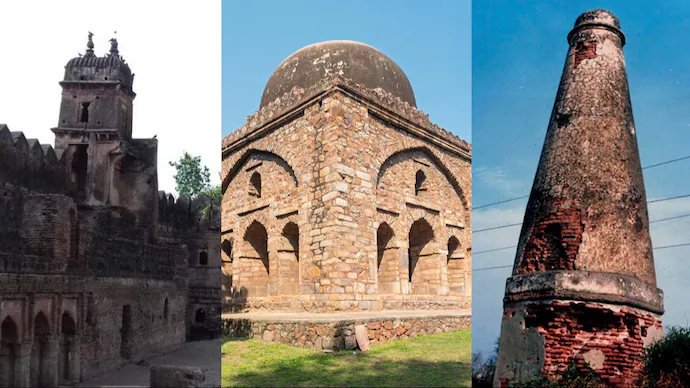Archaeological Survey of India will ‘Delist’ Some ‘Lost’ Monuments

- 27 Mar 2024
Why is it in the News?
The Archaeological Survey of India (ASI) has decided to delist 18 “centrally protected monuments” because it has assessed that they do not have national importance.
Context:
- ASI has decided to delist 18 protected monuments
- ASI says the monuments have ceased to be of 'national importance'
- The 18 'lost' monuments include eleven in Uttar Pradesh
Significance of Delisting Monuments:
- Several monuments are currently facing the prospect of delisting, including historical landmarks such as a medieval highway milestone in Mujessar village, Barakhamba Cemetery in Delhi, Gunner Burkill’s tomb in Jhansi district, a cemetery at Gaughat in Lucknow, and Telia Nala Buddhist ruins in Varanasi.
- The exact whereabouts or condition of these monuments remain uncertain.
Meaning of Delisting:
- Delisting a monument entails its removal from the roster of protected sites, thereby relinquishing its conservation, protection, and maintenance responsibilities by the Archaeological Survey of India (ASI).
- Under the Ancient Monuments and Archaeological Sites and Remains (AMASR) Act, delisted monuments no longer enjoy protection against construction-related activities in their vicinity, enabling regular urbanization and development activities to proceed uninhibited.
Status of Protected Monuments:
- The inventory of protected monuments is subject to change through additions and removals. Presently, the ASI oversees 3,693 monuments, a number set to decrease to 3,675 following the ongoing delisting initiative.
- This marks the first extensive delisting endeavor in several decades.
Procedures for Monument Delisting:
- The regulations governing the List of Protected Monuments are stipulated under the Ancient Monuments and Archaeological Sites and Remains Rules, 1959.
- This legislation safeguards structures and sites aged over a century, encompassing a diverse array of architectural and historical marvels.
- The government possesses the authority to eliminate certain monuments from the protected list via official notification in the Gazette.
- Through such notifications, the government can declare that certain ancient monuments, archaeological sites, or relics no longer hold national significance under the purview of the AMASR Act (Section 35 of the AMASR Act).
Lost Monuments:
- The Ancient Monuments and Archaeological Sites and Remains (AMASR) Act safeguards monuments and sites aged over a century.
- Nevertheless, numerous structures, particularly smaller or lesser-known ones, have gradually disappeared over time due to factors like urbanization, encroachments, dam and reservoir construction, or neglect.
- In some instances, the lack of public memory hampers efforts to locate these monuments.
Extent of Loss:
- According to a submission by the Ministry of Culture to the Parliamentary Standing Committee on Transport, Tourism, and Culture in December 2022, 50 out of India's 3,693 centrally protected monuments were unaccounted for.
- Among these, 14 succumbed to rapid urbanization, 12 were submerged by reservoirs or dams, and the remaining 24 remain untraceable.
- The Committee noted that budget constraints limited the provision of security guards to historical sites, with only 2,578 guards assigned to 248 sites out of the required 7,000.
- Additionally, a 2013 report by the Comptroller and Auditor General (CAG) of India highlighted the disappearance of at least 92 centrally protected monuments nationwide.
About the Archaeological Survey of India (ASI):
- Founded in 1861 by Alexander Cunningham, the Archaeological Survey of India (ASI) was later formalized as a statutory body under the Ancient Monuments and Archaeological Sites and Remains Act, 1958 (AMASR Act) following India's independence.
- ASI's primary mandate encompasses archaeological research and the safeguarding, conservation, and preservation of cultural monuments across the nation.
- Its operational scope includes conducting surveys of antiquarian remains, exploring and excavating archaeological sites, and overseeing the conservation and maintenance of protected monuments, among other responsibilities.
- The ASI operates under the purview of the Ministry of Culture.
Conservationists to propose Kazhuveli watershed region in T.N. for nomination to World Monuments Fund Watch 2025

- 15 Mar 2024
Why is it in the News?
The Eri (tank) network in the Kazhuveli watershed region in the Villupuram district which comprises an incredible network of tanks created thousands of years ago is to be proposed for nomination to the World Monuments Fund Watch 2025 program.
About the World Monuments Fund (WMF)?
- The World Monuments Fund (WMF) is a non-profit organization headquartered in New York, committed to safeguarding and conserving endangered ancient and historic sites worldwide.
- Collaborating with local partners globally, the WMF offers financial and technical assistance to support preservation efforts.
- With a track record of raising over $300 million and securing an additional $400 million from other entities, the WMF has successfully preserved over 700 sites and championed the protection of more than 800 cherished landmarks since its establishment.
World Monuments Watch:
- The World Monuments Watch, initiated in 1996, is a program centered on nominations, fostering a link between local heritage conservation and international engagement.
- Through this initiative, the WMF has allocated over $110 million towards projects at over 300 Watch sites, enabling communities to utilize the platform's visibility to secure an additional $300 million from various funding sources.
World Monuments Fund in India:
In India, the World Monuments Fund (WMF) has focused on conserving significant cultural and ecological sites, including:
- The Kazhuveli Watershed Region: Renowned for its ancient 'Eri' network, an intricate system of tanks dating back thousands of years.
- Situated in the Villupuram district of Tamil Nadu, spanning from Gingee to Marakkanam and extending to the Auroville plateau.
- Proposed pilot projects in Munnur village aim to develop a heritage toolkit applicable across the watershed and beyond if the nomination is successful.
- Suranga Bawadi: An ancient water management system located on the Deccan Plateau in Karnataka.
- Included in the World Monument Watch list for 2020, highlighting its significance for preservation efforts.
